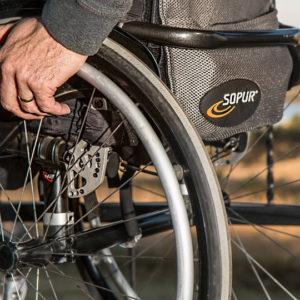
Contents
Anxiety, often considered an invisible disability, comes in many forms and intensities. At times, it can be mild and easily managed, while at others it can be devastatingly crippling. Anxiety often brings with it uncontrollable feelings of tension, apprehension, alarm, or terror that can be triggered by everyday events.
For those suffering from a wide variety of severe anxiety disorders, the mental health impairment may become so severe that daily work life represents an impossible challenge. For these patients, Social Security disability benefits may be a feasible option.
7 Symptoms of Anxiety
Anxiety manifests itself in many different ways, often depending on the specific patient. Below, we’ve listed some of the most common symptoms associated with anxiety disorders.
- Panic Attacks
- Restlessness
- Irrational Fears
- Sleeping Disorders
- Difficulty Concentrating
- Loss of Appetite
- Physical Symptoms
While many of us deal with – and often successfully manage – feelings of stress or worry throughout our workday, those with a severe anxiety disorder can find it difficult to perform day-to-day tasks. If you are experiencing symptoms of anxiety intense enough to affect your ability to complete work- and home-related tasks, then you may have reached a point where your impairment is eligible for SSDI benefits related to your anxiety.
As with all Social Security benefits claims, the Social Security Administration will need to see medical evidence and documentation that you’ve been diagnosed with an anxiety disorder and that its severity renders you unable to work and has done so for some time. Since the SSA does have a listing for anxiety disorders in its Blue Book of qualifying disabilities, your condition also will have to meet the impairment criteria of the Blue Book listing – under Section 12.06 of the Blue Book, with Mental Disorders.
Before you start your claim, be aware that it’s often difficult to prove anxiety as a disability. The medical evidence surrounding anxiety disorders and other mental health issues is often highly subjective and based on criteria that are often hard to document. But that doesn’t mean it’s impossible – working closely with your medical team to present medical evidence that supports your disability claim can help make sure that you’re ultimately successful.
7 Symptoms of Anxiety
Let’s take a deeper dive into the specifics of some common symptoms of anxiety.
Panic Attacks
Panic attacks typically are characterized by the sudden and unpredictable onset of intense fear and sometimes a sense of immediate and unavoidable impending doom. A patient experiencing a panic attack is in full fight-or-flight mode, complete with marked distress including sweating, dry mouth, rapid heartbeat, and a heavy dose of adrenaline. For panic attacks to meet SSA criteria for impairment, they must occur at least once a week on a regular basis.
Irritability
Anxiety often leads patients to engage in socially inappropriate behavior, which can make forging and maintaining healthy work relationships extremely difficult, if not impossible. Since the nervous system is working overtime, it’s easy for patients to become overstimulated and irritable.
Restlessness
Someone in the throes of a severe anxiety disorder has a nervous system almost constantly in overdrive, which can trigger feelings of agitation and restlessness. Patients often report a feeling of being “on edge,” or feeling a constant need to move, which can make day-to-day work tasks extremely difficult in some settings.
Irrational Fears
Also known as phobia, irrational fears of normal situations, objects, or activities can be debilitating for many anxious patients. Many types of phobias exist, but all include avoidance behavior and the potential for panic attacks.
Sleeping Disorders
Anxiety can manifest either as insomnia or excessive sleeping. In either case, the patient is often left groggy and without the ability to think clearly or react quickly and appropriately to many work-related situations. An anxiety patient also dealing with sleep disorders will fatigue very easily and may not have the necessary stamina to make it through an entire work day or week.
Difficulty Concentrating
Concentration is a must for appropriately carrying out work duties. The ability to understand, remember, and appropriately apply information is key to doing a good job. Many patients who suffer from anxiety cannot focus or concentrate when their impairment is triggered.
Loss of Appetite
Anxiety often affects appetite. Chemical changes within your body during feelings of high anxiety often affect the stomach and digestive tract, making it difficult to eat. Though it’s more common to binge eat when feeling anxious, high levels of anxiety do render some others completely unable to eat.
Other Physical Symptoms
The symptoms of anxiety disorders, like those of many invisible disabilities, aren’t necessarily confined to the behavioral and emotional – some people with anxiety disorders report physical symptoms like dry mouth, sweating, and muscle tension, especially while in the midst of a panic attack.
Is Anxiety a Disability?
According to the SSA’s Blue Book listing of disabilities, anxiety-related disorders can qualify as a long-term disability if you can provide a physician’s diagnosis, along with meeting at least three of the symptom criteria outlined above. You also must show that this combination of factors keeps you from being able to perform your job. Anxiety often is treated with psychotherapy or behavioral therapy, along with medication and stress-reducing techniques designed to help control some of the disorder’s most intense and debilitating symptoms.
If treatments are unsuccessful, or if they bring about side effects that also impede your ability to work, your severe anxiety may be considered a disability for benefits purposes.
One point of interest is that the SSA holds a slightly different standard for patients who have been living in a highly structured or treatment-oriented environment. The prevailing theory is that these patients will likely appear in better condition within these environments than they would fare in workplace situations where conditions are more volatile and demands on them would likely be far greater. In this case, if you have documentation showing that you have had a serious and persistent anxiety disorder for at least two years while living in a highly structured treatment environment, you’re still likely eligible for Social Security disability benefits.
How to Qualify for Anxiety Disability Benefits
To qualify for anxiety disability benefits, you must apply with the SSA and go through the same process as for any other disability. You must be able to show that your anxiety is severe enough to have kept you from working for at least one year. Before you begin your Social Security disability claim, you might consider working with a qualified Social Security disability attorney, who can review your claim and advise as to how best to move forward. If your Social Security disability claim is denied on first review, your disability attorney can help guide you through the lengthy and complex appeals process.
Based on the information in your claim, plus your work history, you can apply either for Social Security Disability Insurance benefits, which require that you have previously worked and earned sufficient work credits. Or you may choose to apply for Supplemental Security Income, which does not require you to have earned any work credits as long as you meet income qualifications.
When you apply for SSDI or SSI benefits, there are several anxiety diagnoses that can result in your receiving disability benefits. You may have a diagnosis for a generalized anxiety disorder, PTSD, obsessive-compulsive disorder, a panic disorder, or agoraphobia.
Generalized Anxiety Disorder
Generalized Anxiety Disorder is a constant state of nervousness or worry unrelated to a particular situation. Medical documentation is unclear about what causes generalized anxiety disorder. In some cases, there may be a hereditary component. In others, it may be an individual diagnosis that matches nothing in your family medical history. For an SSA-approved diagnosis, your medical records must show that you’ve been living with a general anxiety disorder for at least six months.
Post Traumatic Stress Disorder
PTSD is caused by witnessing or being involved in a traumatic event. PTSD causes severe stress symptoms that can last more than a month and can be triggered by a wide variety of daily events.
Obsessive Compulsive Disorder
OCD typically manifests as repetitive or ritualistic behaviors that, when performed, help reduce anxiety. These behaviors may include both thoughts and impulses.
Panic Disorder
With this type of anxiety disorder, the patient may suffer panic attacks lasting at least 10 minutes and with no discernible cause.
Agoraphobia
Agoraphobia is an irrational and overwhelming fear associated with common things, situations, or events. Agoraphobia specifically represents a fear of the world beyond a patient’s home, and such patients are typically homebound because of this phobia.
You must submit results of any psychological testing or evaluation that has led to an anxiety diagnosis, and SSA reviewers will especially be interested in any notes or professional comments your physician can provide about your mental health condition. Be prepared to provide a full medical history, including any treatment from your primary care physician, along with treatment provided by any mental health specialists you’ve seen. You’ll need this to establish that your anxiety disorder is either recurrent or persistent.
You will also need to describe to the SSA what happens and how your behavior changes as a result of your anxiety. For example, do you withdraw and become unable to focus or concentrate? Do you become irritable or combative with others? How do these behavior changes as a result of anxiety affect your ability to carry out your work duties? If you can obtain a statement from any past employer about how your anxiety kept you from your job duties, this can also work in your favor.
If the SSA rules that your anxiety disorder is not severe enough to meet the qualifications for anxiety disorders within its listing, you can also get a mental residual functional capacity statement, which will outline exactly what types of work tasks you are capable of completing and at what pace.
For example, if you have a diagnosis of a panic disorder, you’ll likely have problems concentrating for long periods of time. Your RFC will then outline the fact that you can perform short and simple tasks, but not those that require prolonged periods of concentration. Your RFC also likely would recommend that you have no contact with the general public and only limited contact with co-workers and supervisors. To receive Social Security disability benefits, your RFC must indicate that you can’t perform any of your past duties, and you also can’t perform any lower-skill job duties in the United States.
Is Anxiety a Disability?
Unfortunately, normal anxiety is part of everyday life. It stems from a wide range of sources – stressful, though temporary, life situations, reactions to medication, depression, and more. But an anxiety disorder is something more prevalent in a patient’s life. Sometimes, it can render someone incapable of being able to work.
Untreated anxiety symptoms typically grow worse over time, and when unchecked can make normal daily activities like work, school, relationships and even leaving the home next to impossible. When these kinds of marked difficulties are the case, you may be eligible for Social Security disability benefits because of your anxiety disorder diagnosis. With the help of the guidelines presented here and the support of a qualified and trusted disability lawyer, you may be eligible for Social Security Disability Insurance benefits.





Comments are closed.